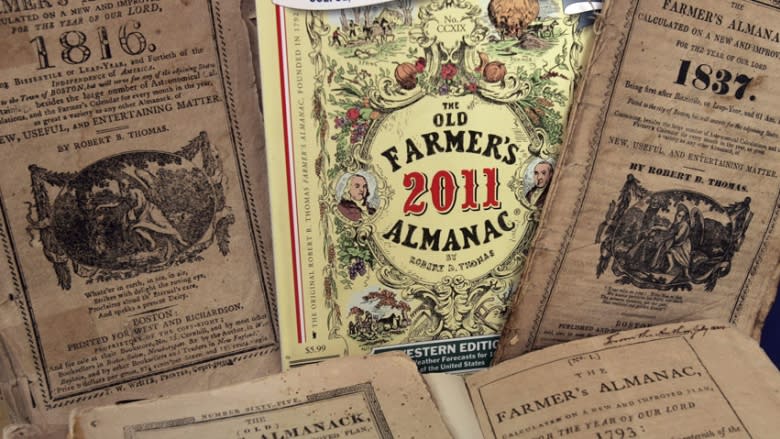How the Old Farmer's Almanac came to be the definitive weather source
Ever wonder how creators of the Old Farmer's Almanac come up with predictions year after year? Or how they became one of the definitive sources for coming weather patterns?
With the oldest continuously published periodical in North America celebrating its 225th edition this year, managing editor Jack Burnett explained to CBC's The Homestretch the history behind that famous title.
"Back in the 18th Century, there were many, many farmer's almanacs. Ours being one of them, [it] started outside Boston in 1792 by a guy named Robert B. Thomas," he said.
"Everyone did their calculations and forecast and so on, they tried to be useful to everyone."
- MORE CALGARY NEWS | Bridging a gap with street art in Bridgeland
- MORE CALGARY NEWS | Calgary Evel Knievel fan honoured at Snake River Canyon jump
While putting together the 1816 edition of the Old Farmer's Almanac in 1815, a printer's helper noticed the entry for July was missing.
The printer's helper was sent to Thomas' farm to find out what he wanted to do.
"The kid went out there and Thomas, it turned out, was sick so Thomas said to him, 'Just put something in there to hold the space,'" Burnett said.
"So as a joke, the kid went back and for July 1816 he put, 'snow and sleet.' As you can imagine, it got printed and ... Thomas was the laughing stock of the almanac world ... until 1816 when it did snow and sleet in July in New England and the Maritimes because of a volcanic eruption in the far east," he said.
"Now he was a genius."
Eventually many of the other almanacs "fell by the wayside," said Burnett, and the Old Farmer's Almanac became the sought-out source.
Traditionally, along with weather predictions, an almanac has included useful things like dates for holidays, weather observations and astronomical events like atral phases and tidal information.
This year's 225th edition will also include some original entries.
"In this new edition we have some reproduction pages from the very first Old Farmer's Almanac, so you can see they had stagecoach routes. They had when the courts were open. They had when the schools were on vacation. Back in those days, the Old Farmer's Almanac was the Google of its day."
The technique used to predict the weather has changed over the last two centuries, but the formula hasn't.
"What Thomas did was, he took three things into account," said Burnett.
"The first one was long-term weather trends or patterns, things that happened over long periods of time. He also used meteorology, localized effects of mountains, lakes, valleys and so on. The third thing that set him apart was he was one of the first weather prognosticators to take into account sunspots, or solar radiation."
That information is then compared to current weather patterns and a prediction made.
Winter predicted to be cold, snowy
So what's going to happen this fall and winter? The skiers and backcountry enthusiasts will be happy.
"Nothing really spectacular for the fall. A little bit warmer, a little bit drier but nothing to speak of, but winter is another matter," said Burnett.
"We're looking for colder, more precipitation and more of that precipitation to be in the form of snow."
Some soothsayers claim cows lying down denotes rain, while others say a surplus of pinecones means a bad winter is coming. Burnett said the tricks are interesting, but not reliable.
"We don't use those folklore things," he said.
"But by that same token, we have thousands of them in our library, and they wouldn't have lasted this long if there hadn't been something to them."
With files from CBC's The Homestretch



